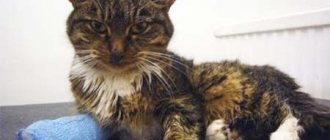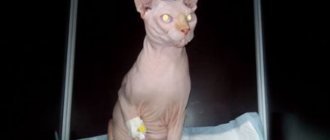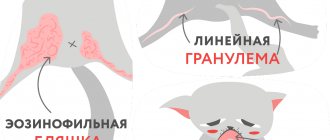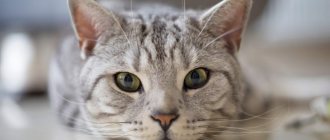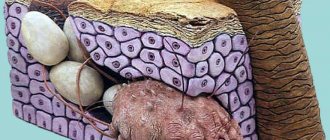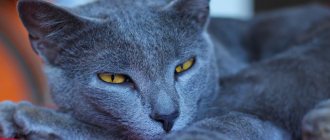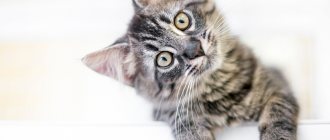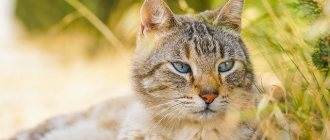Reading time: 5 minute(s) If your pet exhibits symptoms of kidney failure, contact your veterinarian immediately. Without treatment, serious complications are possible.
If the diagnosis of “renal failure” is left without proper attention or is not responded to in a timely manner, the cat’s health will deteriorate sharply, and even death is possible. There is no need to take risks; it is better to contact a veterinarian at the first suspicion. An experienced specialist will accurately determine the stage of the disease, prescribe an effective course of treatment, and advise proper nutrition. In general, he will do everything possible to ensure that the pet is cheerful, cheerful and healthy again.
CRF is a deadly pathology
Causes
Renal failure is understood as a syndrome that occurs against the background of concomitant diseases affecting the genitourinary system. Such diseases include nephrosis, pyelonephritis, urolithiasis and other kidney pathologies. Kidney failure can develop as a complication of diabetes mellitus, pneumonia, vasculitis, leptospirosis, etc.
There are often cases when a cat’s genitourinary system suffers due to poisoning with toxic substances, which occurs, for example, as a result of long-term use of medications. The load on the kidneys increases, as they try to fulfill their direct responsibility as quickly as possible - remove toxins from the body. This can lead to serious consequences, including organ destruction.
Finally, a factor that provokes kidney failure may be your furry's genetic predisposition to certain diseases, for example, polycystic disease, glomerulonephritis.
Renal failure is characterized by two forms of the disease: acute and chronic.
Acute failure is the most dangerous, as in most cases it ends in death. It proceeds rapidly and has a pronounced clinical picture. ARF, in turn, also occurs in three forms: prerenal, renal, postrenal.
Veterinarians say that the most serious form is renal. Regarding prerenal and postrenal, the prognosis is rather favorable.
In chronic renal failure, the kidneys gradually cease to perform excretory functions. For a long time, chronic renal failure may not manifest itself at all. This is why she is dangerous. Kidney cells die gradually, the load is redistributed between healthy cells, but then they die.
Damaged tissues become scarred, causing the kidneys to decrease in size and no longer cope with their duties. As a rule, chronic renal failure is diagnosed in older cats.
CRF has four stages: latent, initial, conservative, terminal.
The latent form has the greatest chance of a favorable outcome, but timely diagnosis occurs in the rarest cases. In case of terminal illness, unfortunately, it is no longer possible to help the animal, so the only way to stop the pet’s suffering is euthanasia.
What's the prognosis?
A favorable prognosis is given to animals with prerenal and postrenal stages of acute renal failure. Those who were diagnosed before stage 3 chronic renal failure also have a good chance. With more serious tissue destruction, but with high-quality nutrition and care, cats with a chronic diagnosis live 2-3 years.
In addition to the form and stage of the disease, an important role is played by:
- presence of concomitant diseases;
- patient's age;
- compliance with medical recommendations.
Older pets are more difficult to tolerate pathology, so in their case, doctors are in no hurry to make a prognosis. An unfavorable outcome is also observed in animals at risk who suffer from amyloid dystrophy or polycystic disease. With this diagnosis, over 90% of tissues are destroyed. This condition turns out to be incompatible with life.
Symptoms
If we are not talking about an acute form of renal failure, then for a long period the pathology occurs in a latent form. Gradually the cells die, but the kidneys continue to work. Characteristic signs of renal failure appear when the volume of damaged tissue is more than 70%.
A cheerful and active pet becomes lethargic, sleepy, gets tired quickly and lies down most of the time. His appetite disappears, and his thirst, on the contrary, increases. Despite drinking a lot of water, the cat rarely goes to the toilet. Even if he manages to pee, the amount of urine is insignificant. The owner notices that the fluffy is constantly licking the genitals.
Then there are digestive disorders - nausea, diarrhea, constipation.
The appearance of a sharp unpleasant odor from the body and mouth of a four-legged pet is typical.
In severe cases, the animal experiences epileptic seizures, convulsions, fever, hypertension, which results in rupture of blood vessels in the eyeball and loss of vision. Intoxication of the body increases, the cat’s condition rapidly deteriorates. The kidneys do not work, causing the pet to fall into a coma and die.
Uric acid, cystine, oxalate...
As we have already said, kidney stones are very different in structure - uric acid, cystine, oxalate... Determining which mineral you have grown inside is important! At least in order to free yourself from the existing stone and try to avoid the formation of new ones.
Diagnosis of urolithiasis is carried out using ultrasound or intravenous urography. Using intravenous urography, the doctor takes several x-rays of the urinary system. To do this, a radiopaque substance is injected into the bloodstream, which spreads throughout the body until it reaches the kidneys, through which it is discharged through the ureters into the bladder.
Diagnostics
Diagnosing renal failure is associated with certain difficulties. It can be carried out qualitatively only in a hospital, using instrumental and laboratory methods.
First of all, blood biochemistry is carried out. The study allows you to find out the level of phosphorus, potassium, creatinine, and urea.
A lot of information can be obtained from a laboratory urine test, in particular, it indicates a change in the composition of the biological fluid, determines the level of leukocytes, the presence of bacteria and renal epithelium. The urine of a sick cat is dark or, conversely, too light and has low density. The content of red blood cells and protein is increased.
An ultrasound of the kidneys is required. It shows the structure of the organ, its location and shape, and the presence of cysts.
To determine the extent of kidney damage, radiography with a contrast agent is performed.
The most accurate information is provided by computed tomography of the kidneys. But due to its high cost, it is used in rare cases.
Do you like salty foods? Be carefull!
Due to metabolic disorders in the body, conditions are created for the precipitation of salts, from which stones are formed. This disrupts the flow of urine, which, in turn, leads to a disease called urolithiasis.
The formation of stones is facilitated by long-term consumption of foods containing large amounts of mineral salts, as well as stagnation of urine in the urinary tract - kidneys, ureters, bladder. Depending on the composition, the stones differ in their origin. Thus, uric acid (urate) stones are formed from uric acid salts, oxalate stones from calcium oxalate, and calcium phosphate stones from calcium and phosphate salts. Stones can grow to very large sizes, sometimes repeating the outlines of the renal pelvis and having a coral shape.
Treatment
Kidney failure is one of the incurable pathologies. However, with the help of a well-designed treatment regimen, it is possible to maintain the animal’s quality of life and achieve some improvement in kidney function.
The cat will be under the supervision of a veterinarian for life and undergo regular examinations, including urine and blood tests. In addition, the animal will have to follow a therapeutic diet and take certain medications for the rest of its life.
Treatment depends on the form of renal failure, the general condition and age of the animal.
The acute form is treated according to a regimen that includes:
- elimination of the factor that provoked the deficiency;
- restoration of water balance;
- hemodialysis (artificial blood purification);
- removal of intoxication;
- decreased blood pressure;
- special medical nutrition.
In case of chronic insufficiency, therapeutic measures are aimed at restoring the acid-base, water-salt balance, and stabilizing blood pressure. Elimination of signs of anemia. It is necessary to undergo hemodialysis and use a strict but nutritious and balanced diet.
To improve immunity, it is advisable to use vitamin and mineral complexes.
How are acute renal failure and chronic renal failure treated?
Kidney failure in cats is incurable. Unlike hepatocytes (liver cells), nephrons do not regenerate. Treatment is aimed at increasing possible life expectancy and maintaining its quality.
A sick pet will have to undergo regular tests and take medications to prevent its kidneys from failing. More detailed therapy will depend on the course of the pathology:
- Acute
. After identifying and eliminating the root cause, rehydration is carried out to eliminate the effects of dehydration. With the help of medications, the patient eliminates hemolysis (destruction of red blood cells) and relieves the consequences of poisoning. In especially severe cases, hemodialysis is prescribed. After inpatient treatment, the animal is sent home and put on a recovery diet.
- Chronic
. Without starting from the cause, doctors try to stimulate appetite with the help of a maintenance diet. Blood pressure and all metabolic processes are normalized. The consequences of anemia are eliminated with hematopoietic drugs (Ursoferran, Recormon, Hemobalance). More vitamins are added to the diet. Hemodialysis is mandatory.
Without finding out the root cause, it is impossible to stop the pathological process. Remission after symptomatic treatment will certainly end in relapse. Ultimately, the pathology will become chronic.
List of medications
It is impossible to say how long a pet will live before starting treatment. Life expectancy depends on the body's response to the medications used. The veterinarian may prescribe:
- glucocorticosteroids (Dexamethasone, Prednisolone, Methylprednisolone), suppressing immune reactions and relieving swelling;
- diuretics (Furosemide), laxatives (Lactusan, Duphalac) and antiemetics (Famotidine, Metoclopramide) drugs;
- potassium-containing drugs (Panangin), which replenish potassium levels;
- rehydration and nutritional solutions (Ringer's solution, glucose, Trisol, saline solution), eliminating the effects of dehydration and normalizing metabolic processes;
- drugs to lower blood pressure (Ramipril, Enalapril);
- detoxification (Liarsin, Sirepar, Enterosgel) and hemostatic (Vikasol, Ditsinon) drugs;
- antibiotics (Baytril, Enrofloxacin, Sinulox) that eliminate primary factors;
- cardiogenic drugs (Riboxin, Cocarboxylase, Sulfocamphocaine) that prevent ruptures in capillaries.
To restore appetite, the animal is forcibly administered nutrient mixtures hourly. Intestinal microflora is normalized with medications containing beneficial bacteria.
Self-selection of medications is unacceptable. The treatment regimen is developed based on the patient's diagnosis. The veterinarian can replace the listed drugs with others, expand or reduce the list.
Lifelong diet and care
Regardless of the form of the disease, treatment involves following a diet. You will have to stick to the new menu for at least six months. Returning familiar products immediately after eliminating symptoms is unacceptable, since the doctor makes this decision only on the basis of changes in the tests. If kidney damage is over 75%, the therapeutic diet is followed for life.
Dairy products, fatty meat and fish, salt, fish oil and caviar are prohibited. The abundance of phosphorus complicates the course of the disease, negatively affecting the condition of the bones and central nervous system. Its daily rate is reduced to 65-85 g per 1 kg of animal weight.
It is allowed to eat lean meats (chicken, rabbit, turkey), cabbage and carrots. Twice a week the cat is given boiled chicken hearts and liver. Meat is served boiled or raw. In the latter case, it is well frozen in the freezer to destroy all parasites. Offal is served strictly boiled after deep freezing. There should be no more than 4.5 g of protein per 1 kg of cat weight.
At high urea values (30 mmol/l), energy must be obtained from unsaturated fats and carbohydrates. Proteins are temporarily excluded. The patient is fed oat pancakes, pasta with vegetable oil and bread. A small amount of sugar is added to dishes.
Provide constant access to fresh water and feed your pet in small portions. Don't go hungry. When refusing food, hand feed the patient, administer liquid food through a syringe, or heat food before serving to enhance its flavor.
When dry feeding, it is recommended to choose medicated food labeled Renal. This product contains reduced protein and phosphorus and is available in the form of granules and mousse.
Avoid independent walks outside to protect your pet from injury and infection. Do not touch his stomach, as any touch will cause severe pain and aggravate the condition. Place the sick cat in a quiet and warm place, protected from outside noise and drafts.
Self-installation of an IV
To reduce the load on the kidneys, veterinarians prescribe subcutaneous infusions of saline. Sometimes saline solution is mixed with other drugs. The dosage, duration of the course and its repeated use are prescribed only by a veterinarian.
Sometimes infusions need to be done for a long time - up to a month continuously, if the condition of the kidneys is poor. Taking your cat to the veterinarian every day is not only expensive, but also dangerous for the animal’s health, since excess stress aggravates the situation.
Some owners call a veterinary nurse to their home, while others decide to carry out the procedure themselves. In fact, subcutaneous infusions are not that complicated, and mastering them is easier than it seems.
The dropper is placed at the withers, since this is where cats have the least nerve endings and the most space for fluid. The volume of a single infusion can range from 50 to 100 milliliters at a time. The vast majority of people with mustaches tolerate the procedure calmly.
It is most convenient to use the so-called “butterfly”: it is a short needle with a large cavity, it speeds up the administration of the drug. Protective “wings” do not allow the tip to slip out, even if the cat begins to struggle during the procedure. For large cats, a thicker needle is recommended, No. 18-19, for medium-sized cats – No. 20-21, for kittens – a needle No. 23.
The needle is equipped with a long “wire”, at the end of which a syringe is inserted. With such a device, making even large subcutaneous infusions is convenient and simple. The most that your pet may not like is that the saline solution tingles slightly, but it is not a painful sensation.
Have one person hold the cat while the other puts in an IV. Another option is to get a retainer bag. You need to strongly pull the skin on the upper part of the neck and insert the needle perpendicular to the spine. Inject the solution neither too quickly nor too slowly, then carefully remove the needle. The cat should not experience any blood or severe pain.
What to do at home
The owner must strictly follow the veterinarian's instructions. Self-medication and replacement of traditional methods of conservative treatment lead to detrimental consequences.
A sick pet needs to be provided with quality care and therapeutic nutrition. The diet lasts for at least six months. At this time, salt, sea fish, fatty meats, offal, cereals, and dairy products are completely excluded from the cat's menu. Flour products and fish oil are prohibited.
The diet may consist of poultry (chicken, turkey), broth, vegetables (cabbage, carrots). There are few acceptable products, so veterinarians recommend giving preference to special medicinal dry food.
Prevention of kidney failure in cats
To avoid kidney problems, cats over 5 years of age are recommended to undergo quarterly medical examinations. Detecting pathology at an early stage will allow for greater success in treatment. Our veterinary clinic AMVet accepts patients around the clock; you can make an appointment by calling the contact number or by contacting the administrator on duty. If a cat detects signs of kidney disease, it will be examined, and if the diagnosis is confirmed, the necessary treatment will be prescribed.
Classification of kidney diseases
Based on the location of the primary pathological process, kidney diseases are divided into:
- Primary.
- Secondary.
The first group includes diseases in which the pathological process began directly in the kidneys. The second group included kidney damage as a result of hypertension, diabetes, and diseases of the genitourinary system.
According to the nature of the disease, the following are distinguished:
- Acute;
- Chronic.
In addition, congenital and acquired diseases are distinguished. Congenital - the result of genetic disorders in certain breeds of cats. The risk group includes Somali, Persian, Abyssinian and Himalayan breeds.
Why does diarrhea occur after taking antibiotics?
The development of complications during antibacterial therapy in the form of diarrhea is associated with a decrease in beneficial microflora, which is involved in a complex of digestive processes:
- breakdown and absorption of nutrients from food;
- evacuation of the contents of the stomach and intestines;
- residual digestion of food;
- removal of toxins and metabolic products;
- secretion and absorption of water in the intestine;
- formation of feces, regulation of their excretion.
Even with standard antibacterial therapy, leading to a slight imbalance, side effects may occur in the form of disruption of intestinal function.
In addition, bacterial infections themselves can contribute to diarrhea, which is the basis for taking antibiotics. The waste products of pathogenic bacteria have a toxic effect, and stool liquefaction may be associated with an increase in body temperature. Antibiotics fight the underlying agent and root cause of the disease, and in many cases they are truly necessary. However, this group of medications can worsen the digestive system.
